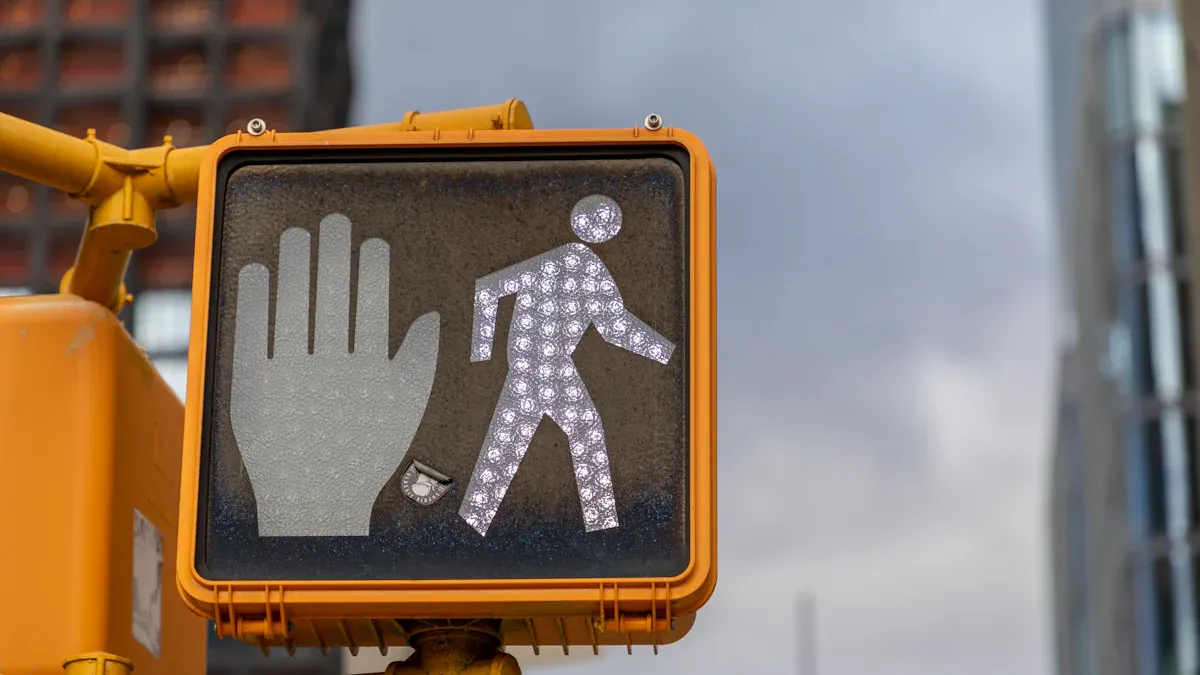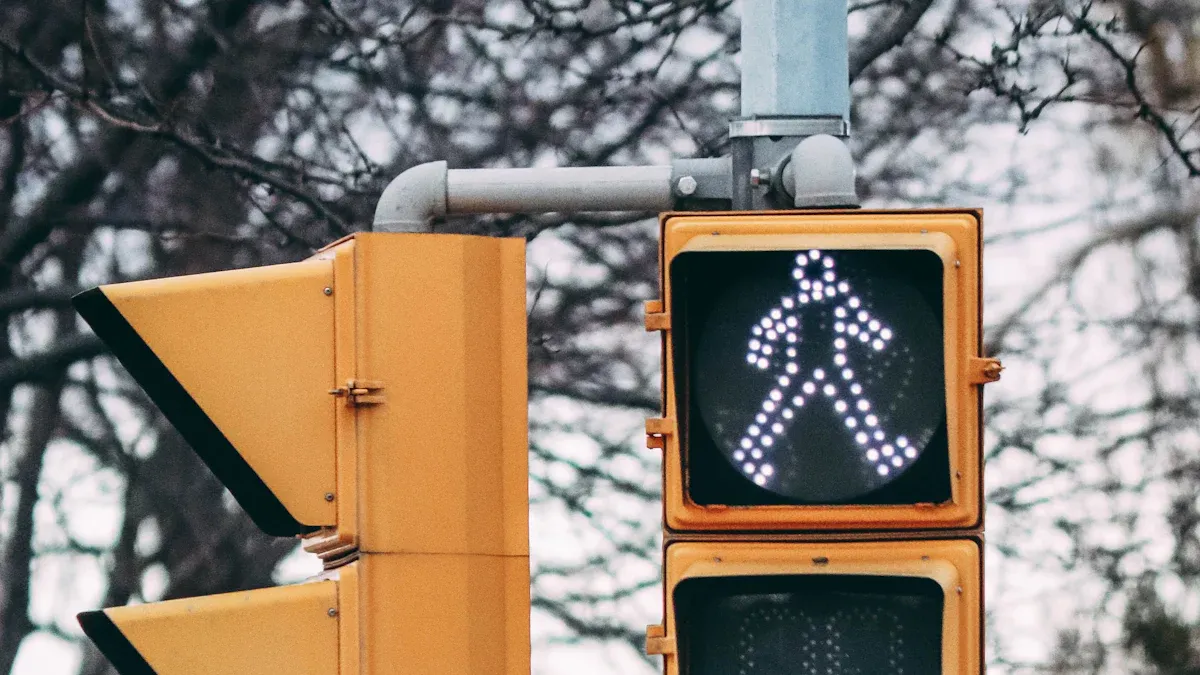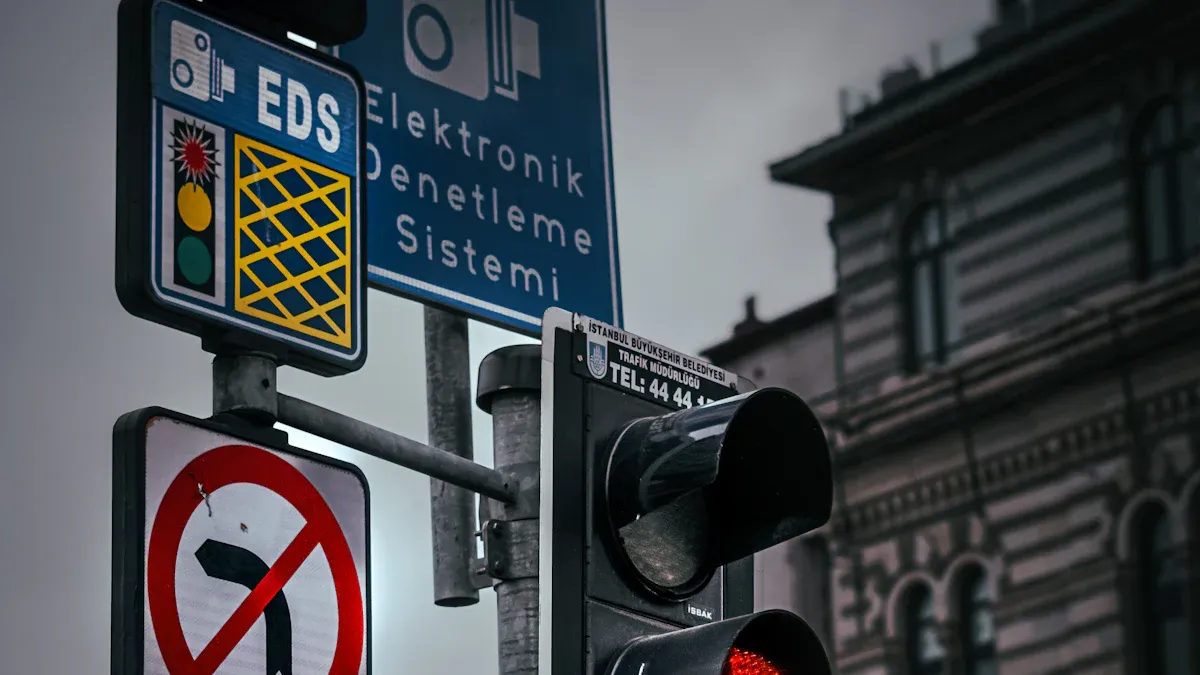The Evolution of LED Traffic Signs: Safety Innovations and Smart Technology Integration

LED Traffic Signs make roads safer for you every day. You see brighter signals in fog, rain, and snow. This helps drivers not get confused.
After cities put in LED stop signs, right-angle crashes went down by 42%.
Drivers stopped at intersections 10.6 times more with flashing LED signs than before.
Feature | LED Traffic Signs | Traditional Traffic Signs |
|---|---|---|
Visibility in Adverse Weather | Bright colors stay easy to see in fog, snow, rain | Harder to see in bad weather |
Advanced Visibility Features | Optical lenses and wider viewing angles | Regular design, not many ways to see better |
You can find these upgrades in the Product section, About Us page, and even when you get home after work. Led Light technology makes these changes happen.
Key Takeaways
LED traffic signs help people see better in bad weather. This makes roads safer for all drivers.
Smart technology in LED signs warns drivers more quickly. This helps stop accidents from happening.
Adaptive brightness makes signs easy to see at any time. This helps keep everyone safe.
Real-time data lets traffic lights change fast when things happen.
Solar-powered LED signs use less energy and cost less for cities. This is good for the environment.
History of LED Traffic Signs
Early Traffic Signals
Long ago, traffic signals did not use LED technology. They used incandescent bulbs instead. These bulbs were not very bright. Drivers sometimes missed signals when the sun was shining. Cities had to spend a lot of money to replace bulbs often. Old signals could not send updates or changes quickly.
Tip: Early traffic signals were hard to see and used lots of energy, so roads were not as safe.
Rise of LED Technology
LEDs changed traffic signals a lot. California put in the first LED main traffic light in 1989. The new lights lasted longer and used less energy. LED lights were much brighter. Drivers could see signals in any weather. LED traffic signs did not need to be replaced as often as old ones.
Here is a quick look at the first LED traffic light:
Year | Event | Results |
|---|---|---|
1989 | First LED main traffic light introduced in California | Lights lasted longer and used less energy than older ones |
LED technology fixed many problems. Signals were easier to see in fog and rain. Cities saved money because LEDs used less power and lasted longer.
Key Milestones
Many important things happened with LED traffic signs.
LED STOP signs helped drivers see better during the day.
BlinkerSign® brought flashing lights you could see anytime.
Governments liked LED signs because they saved money and were safe.
Dimming technology let LED signs change brightness and save battery.
MUTCD approval came after research showed fewer cars ran STOP signs.
New technology lets people control signs from far away.
These changes help you every day. LED traffic signs stop wrong-way driving by 38%. They also lower speeding on curves by 30%. Every new step makes roads safer and smarter for everyone.
Safety Innovations and Visibility

Enhanced Visibility Features
When you drive by LED traffic signs, you see a big change. These signs use special features to help you see messages from far away. They also work well in bad weather. LED lights are brighter than old bulbs. This makes signs easy to spot in fog, rain, or at night. You can react faster and make safer choices because you see signs better.
Note: The main goal is to help you see and stay safe. You get fewer accidents and clearer directions because of these changes.
Many LED signs use extra features to help you see better and stay safe. Here are some examples:
Type of Sign | Visibility Feature | Effectiveness |
|---|---|---|
LED-Enhanced Stop Signs | Bright red LED lights help you see in bad weather. | 52.9% fewer drivers run through stop signs, says FHWA. |
Pedestrian Crossings | Push buttons or motion sensors turn on pavement lights. | 23% more drivers stop for people after these were added in Vermont. |
Rectangular Rapid Flash Beacon | LED signs flash when people cross the street. | 80% of drivers stop, much more than regular beacons. |
School Zones and Crosswalks | Flashing LED panels help keep kids and walkers safe. | More people see the signs, so there are fewer close calls. |
Curve and Winding Road Warnings | Reflective chevrons or LED signs warn drivers early. | These signs help stop rollovers and cars running off the road. |
You see these features every day. LED stop signs help lower crashes at intersections. Pedestrian crossings with LED lights keep people safe at night. Curve warnings help you avoid sharp turns.
A study from Texas A&M Transportation Institute found LED signs are easier to read. Legibility distance went up by 267%. Another study showed it is much easier to see signs at night.
Feature | Improvement (%) | Source |
|---|---|---|
Legibility distance | 267 | Texas A&M Transportation Institute (TTI) |
Nighttime visibility impact | Big improvement | LegendViz® Sign Legibility Study |
These features help you stay alert and safe wherever you drive.
Adaptive Brightness
LED traffic signs change brightness when light changes outside. Signs look brighter in the day and softer at night. Power systems sense how much light is around and adjust the sign’s brightness. You see signs clearly without glare, so your eyes stay comfortable.
Auto-dimming lowers brightness at night so drivers are not blinded.
In bright sunlight, signs get brighter so you can see them.
Adaptive brightness can lower accidents by up to 20%.
You get help from this technology every time you drive in different light. Adaptive brightness makes sure you always see messages, day or night.
Weather and Environmental Adaptation
LED traffic signs also change for weather and the environment. If you drive in rain, snow, or fog, these signs still shine. Automatic brightness helps signs cut through bad weather. You do not miss warnings or directions.
Power systems change brightness for weather and light.
LED signs stay readable in storms, fog, or bright sun.
Even during power outages, many LED signs keep working with backup power.
You count on these changes for safety and smooth traffic. LED traffic signs use smart technology to keep you safe and informed. These upgrades help cities control traffic and protect everyone.
Smart Technology in LED Traffic Lights

Today’s LED traffic lights use smart technology to help keep roads safe. These new features make traffic move better and help prevent crashes. You might not notice, but these changes are all around you. Sensors, data, and artificial intelligence work together in these lights. They help cities watch traffic, stop accidents, and keep cars moving.
Real-Time Data Integration
LED traffic lights use real-time data to help drivers. The lights collect information from many places to make fast choices. Sensors count cars, check their speed, and see what kind of vehicles are there. They also watch how fast cars speed up or slow down. If there is a traffic jam or crash, the system knows right away. Some systems check how long it takes cars to get through. Parking sensors in garages and lots tell you if spaces are open. This helps your phone or GPS find you a parking spot.
Sensors count cars, check speed, and see vehicle types.
Systems check travel times and find slow traffic.
Parking sensors show open spots right now.
Smart traffic lights use this data to change the light times. If an ambulance or fire truck is coming, the lights can turn green for them. This is called emergency vehicle preemption. It helps emergency vehicles get to people faster. Artificial intelligence can spot emergencies and change the lights right away. This makes help arrive sooner.
Note: Real-time data means less waiting, faster help, and safer roads.
Vehicle Detection
LED traffic lights use special sensors and cameras to watch for cars, bikes, and people. When the system sees a car or person, it can change the light to keep everyone safe. This helps stop crashes and keeps traffic moving.
Evidence Type | Description |
|---|---|
Vehicle Detection | Sensors see cars and people, so lights change on time and stop crashes. |
Pedestrian Safety | Lights change quickly to help people cross busy streets safely. |
Traffic Flow | Real-time data lets lights change to keep traffic moving and stop jams. |
Congestion Reduction | Watching car numbers and speed helps lights change, so there are fewer delays. |
You stop less and drive smoother because of these smart features. LED traffic lights change when they need to, so you wait less. Cities with these systems see big improvements:
Outcome | Improvement Percentage |
|---|---|
Traffic throughput at intersections | 15–25% |
Urban travel times reduction | Up to 20% |
Travel time reduction (Pittsburgh) | 25% |
Idle time reduction at intersections | 40% |
Smart LED lights change as traffic changes.
Good sensors mean less stopping and smoother driving.
These devices help cut down on delays.
Connectivity with Traffic Systems
LED traffic lights connect to city traffic control centers. This lets cities change the lights from far away and react to problems fast. The system can change light times, send cars different ways, and give drivers updates. Dynamic Message Signs (VMS) tell you about traffic, weather, and new routes. These signs talk to control centers using radio or networks, so you always know what’s happening.
Benefit | Description |
|---|---|
Reduced Traffic Congestion | Smart systems change lights and send cars new ways to stop traffic jams. |
Enhanced Road Safety | Systems see crashes and bad weather, then act fast to keep people safe. |
Environmental Benefits | Better traffic flow means less gas used and less pollution. |
Cost Savings | Using less gas and fixing things less saves money for cities. |
Improved Public Transport Efficiency | Smart systems help buses and trains run on time. |
Dynamic Message Signs give drivers live updates.
VMS help control traffic by sharing news about roads and routes.
You see these smart changes every day. The system can keep green lights on longer for busy roads. It can clear the way for emergency vehicles. It can help people on bikes and walkers cross safely. Some LED lights talk to phone apps for people who cannot see well. Bike signals and special times for bikes are now in many cities. Cars and traffic lights can even talk to each other to make things work better.
Tip: Smart LED technology, sensors, and AI make roads safer, faster, and better for everyone.
Road Safety and Efficiency
Accident Reduction
You see fewer crashes because of led traffic lights. These lights help you notice signals faster, even in bad weather. The main goal is to make roads safer. Led traffic signs warn you about sharp turns and crosswalks. They also warn you about school zones. When you drive, digital signals flash or change color to get your attention. Automated systems use sensors to find problems and send alerts. Emergency vehicle preemption lets ambulances and fire trucks move through intersections quickly. This technology helps save lives and keeps you safe.
Tip: Led traffic lights lower crash risk by making signals easier to see and react to.
Traffic Flow Optimization
Led traffic lights use smart technology to keep cars moving. You wait less at red lights because signals change based on how many cars are there. In Shanghai, adaptive signals cut waiting time almost in half. They also lowered CO₂ emissions by 16%. Longer red lights during busy times help control traffic jams. Shorter red lights during quiet times let you drive smoothly. Sensors like inductive loops and radar collect real-time data to adjust signal timings. Pedestrian detection systems use infrared or video sensors to give people safe crossing times.
Evidence Type | Description |
|---|---|
Adaptive Signals | Less waiting and lower CO₂ emissions in Shanghai |
Traffic Volume Management | Changes red light times for better traffic flow |
Vehicle Detection Systems | Uses sensors to reduce delays and improve efficiency |
Pedestrian Detection | Gives safe crossing times for walkers |
You benefit from these new ideas every day. Led traffic signs and lights make traffic control smarter and more helpful.
Energy Efficiency
Led traffic lights use much less energy than old bulbs. You help the environment when cities switch to led signals. More than half of traffic signals in the U.S. now use leds. Led lamps use only 10% of the energy that old lamps need. At one intersection, cities can save up to $600 each year. In Palermo, Italy, dimming led lighting saved up to 84% in energy. Led signs last longer, with lifespans reaching 50,000 hours. Modern led signs use only 12-20 watts per foot. Old fluorescent signs use 60-80 watts. Led traffic signs can run on solar power, making them even more green.
Led traffic lights cut electricity costs by 60-80%.
Led signals are about 95% recyclable.
Led technology means less waste and lower pollution.
You see the benefits in lower city costs and cleaner air. Led traffic lights and signs help make road safety and traffic management better.
Future of LED and Smart Traffic Signs
AI and Predictive Analytics
Big changes are coming to led traffic lights because of artificial intelligence. AI and machine learning look at lots of data from cameras, sensors, and social media. These systems find traffic patterns and guess where jams might happen. You get alerts on your phone or see updates on digital signs when traffic gets busy. AI-powered cameras spot blocked lanes and send quick messages to traffic teams. When traffic is heavy or there is an emergency, smart signals change light times to keep cars moving. Cities like Los Angeles and Pittsburgh use these systems to cut travel time by up to 40%. AI helps you avoid traffic jams and makes your trips easier.
AI checks real-time and old data to guess traffic hotspots.
Traffic lights change by themselves to stop jams and help you move.
You get messages about crashes or delays from smart signs.
AI helps make roads safer by giving you fast, smart solutions.
Solar Power and Sustainability
You help the planet when you drive past solar-powered led traffic lights. These signs use sunlight to work, so cities save money and lower pollution. Solar led signs need less fixing because they last longer and handle bad weather. They keep working even when the power goes out, which helps in emergencies. Cities spend less on repairs and save money.
Benefit | Description | Impact |
|---|---|---|
Energy Cost Savings | Solar signs use renewable energy, no electric bills | Cuts costs by up to 80% |
Minimal Maintenance Costs | Strong and weatherproof materials | Fewer repairs and problems |
Carbon Footprint Reduction | Clean energy, less fossil fuel use | Lowers greenhouse gases |
Solar led traffic lights help cities use less energy from power plants. You see cleaner air and less trash. Businesses and towns pick these signs to help the earth and save money.
Connected Vehicles
Soon, more cars will talk to led traffic lights. New technology lets cars and signals share information. V2X lighting sends updates to your car about road problems or dangers. LED-based visible light communication uses the lights to send messages to cars right away. Your car can read these signals and get news about traffic or accidents. Some systems let cars send information back to intersections or toll booths using special LED systems.
Technology | Description |
|---|---|
V2X Lighting | Sends messages or talks with self-driving cars |
LED-Based VLC | Uses light for quick updates between signals and cars |
Bidirectional LED System | Cars send and get data with LEDs at intersections or tolls |
You get safer roads and faster help in emergencies. Connected cars and led traffic lights work together to make traffic better and keep you safe.
In the next ten years, you will see more smart signals, solar-powered signs, and connected cars. These new ideas make roads safer, cleaner, and smarter for everyone.
You notice roads are safer because of LED technology. Smart systems help you know what is happening. They also help stop accidents. Smart signals change with traffic in real time. This means you wait less and stay safe. Automated systems watch and control traffic. This makes roads work better. Cars and signals talk to each other to stop crashes. New ideas will keep making your drive safer and smarter every day.
FAQ
What makes LED signage better than traditional signs?
You can see LED signage easily in bad weather. The bright lights help you see at night or in fog. Smart features make messages clear every time you drive. Cities pick LED signage because it lasts longer. It also saves money for the city.
How does LED signage help with traffic management?
LED signage shows you updates about road conditions right away. You see speed limit changes and warnings fast. This helps you avoid traffic jams and keeps cars moving. LED signage makes traffic management smarter and easier.
Can LED signage work during power outages?
LED signage keeps working even if the power goes out. Many systems use backup batteries or solar power. You still see important messages and warnings in emergencies. LED signage helps keep you safe all the time.
How does LED signage improve safety for pedestrians?
LED signage uses flashing lights and sensors at crosswalks. You notice these signs quickly when you walk. Pedestrians get more time to cross the street safely. LED signage lowers accidents near schools and busy places.
Where do you see LED signage used in transportation?
You see LED signage on highways, city streets, and parking lots. These signs help guide you and show directions. Transportation systems use LED signage to keep roads safe and organized. You find LED signage technology in many places.
See Also
Enhancing Road Safety With Efficient LED Highway Lighting
Trends And Innovations Shaping LED Street Lighting Today
Understanding The Advantages And Technology Behind LED Street Lights
All You Need To Know About LED Street Light Technology
Why LED Signs Are Superior To Traditional Outdoor Advertising

